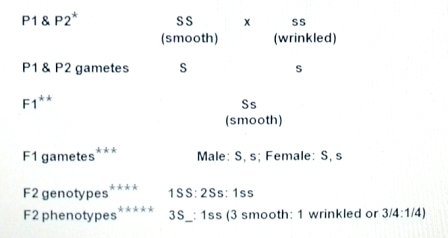The Law of Segregation is further explained with the aid of the illustration below.
The illustration uses the contrasting characters smooth vs. wrinkled seeds in Gregor Mendel’s experiments which led to the birth of the modern science of genetics.
The genotypes are provided correspondingly with the capital letter S representing the gene for smooth and the small letter s for the wrinkled character.

Law of Segregation
This illustration of the Law of Segregation shows that:
1. * Both parents (P1 and P2) are true-breeding diploid plants or purelines with homozygous genotypes (SS and ss).
However, there is no indication as to which is the male or female parent because it does not matter which is which.
In Mendel’s preexperimentation, it was shown that reciprocal crosses yielded the same results.
2. ** As a result of cross fertilization (SS x ss), the gene for smooth seeds (S) and that for wrinkled seeds (s) that are carried by the gametes of P1 and P2 are combined in the F1 hybrid (the F1 genotype is denoted Ss which indicates that both S and s are present).
This conforms with the first statement in the Law of Segregation that a hybrid between two parents differing in a set of characters possesses both parental factors.
However, the certainty of this conclusion is not apparent in the phenotype of the F1 plants.
Although both genes for the contrasting characters are present, the hybrid exhibits only the smooth character.
This is because of the intraallelic interaction (interaction between alleles belonging to the same gene pair) called complete dominance.
Here the capital S allele for smooth is completely dominant over the smalls allele so that the former (S) manifests itself to the complete exclusion of the wrinkled character which is carried by the s allele.
3. *** The parental factors S and s in the F1 segregate in the gametes.
There is 1:1 segregation of the S and s genes in the F1 during reproductive development to produce S- and s-carrying sexual gametes.
Both the male sperm cells in the pollen and the egg cells in the female embryo sac consist of S- and s-types of gametes in the proportion of 1:1 or one-half are S-type and the other half is s-type.
Stated another way, the gametic ratio in the sperm cells is 1S:1s or 1/2S:1/2s which is exactly the same in the egg cells.
This is consistent with the segregation clause of the law that both parental factors segregate or separate in the gametes.
4. **** Selfing of the F1 (represented by the cross Ss x Ss) results to the F2 or second filial generation with a genotypic ratio of 1SS:2Ss:1ss.
This confirms that the parental factors S and s are combined in the F1 and that these segregate equally during gamete formation.
With the segregation of S and s genes, the resulting genotypic ratio of the second filial progeny can only be 1SS:2Ss:1ss.
The genotypes are derived from the following union of gametes during the process of fertilization: S + S = SS, S + s = Ss, s + S = Ss, and s + s = ss or 1SS:2Ss:1ss or, expressed in terms of probability, 1/4SS:2/4Ss:1/4ss.
5. ***** The symbol S_ (Sblank) refers to the smooth plants which consist of the two F2 genotypes SS and Ss; 1SS + 2Ss = 3S_.
The phenotypic ratio 3S_ :1ss or 3 smooth to 1 wrinkled in the second filial generation or F2 is a visible confirmation that parental traits are carried by elementary units now called gene and that genes are transmitted by the parents to their progeny.
That both the genes S and s are transmitted to the F1 plants is confirmed by selfing.
Fortunately, the garden pea does not need to be artificially selfed because it is largely a naturally self-pollinated plant.
With rare exceptions, the next generation progeny, therefore, consists of selfed plants.
Evaluating the F2 individuals, there is reappearance of the wrinkled character although only 1/4 of the individuals are wrinkled while 3/4 are smooth.
Nevertheless, if the parental factors for the wrinkled seeds have not been transmitted to the F1, then the F2 (and other succeeding selfed progeny) should not exhibit the character.
Therefore, its reappearance in the F2 only shows that it has been transmitted to the F1.
More explanatory notes
To be clear, it is not possible to identify smooth F2 plants as either belonging to the genotype SS or Ss by visual inspection.
This can only be done, as Mendel did, by continuous selfing of the smooth plants and the resulting progeny.
With two successive selfings of a sufficient number of smooth F2 plants (S_), it will be shown that S_ will yield SS and Ss plants in the proportion 1 to 2.
The SS type (pure smooth) plants are those which yield only smooth plants while the Ss type yields selfed progeny consisting of 3:1 smooth and wrinkled seeds.
Further, the illustration establishes constants with multiple uses in predicting the genotypic and phenotypic frequencies in the selfed generations subject to limitations.
For the F2 genotypes, the probability constants are 1/4 for homozygous dominants (e.g. 1/4SS), 2/4 or 1/2 for heterozygous (e.g. 2/4Ss), and 1/4 for homozygous recessive (1/4ss), with an expectation of 3 types of genotypes (SS, Ss, and ss) provided that the gene pair consists of two alleles.
For the F2 phenotypes, it is expected that there will be 2 types with 3/4 for dominant (3/4S_) and1/4 for recessive (1/4ss) with the additional condition that (1) intraallelic interaction is complete dominance and (2) there is absence of interallelic interaction or it is presumed to be non-existent.
REFERENCE
ROOK A (ed.). 1964. The Origins and Growth of Biology. Harmondsworth, Middlesex: Penguin Books, Ltd. p. 294-311.
